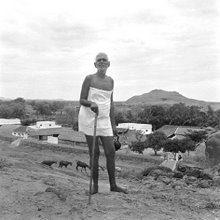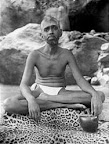WHAT next? Bhagavan once said, "So long as Swami is there, nothing will happen. Later, voices will be raised."
Bhagavan's demise became unbearable for several bhaktas most of whom left within a couple of days. Ramanasramam, then resembled Ayodhya after Rama's departure, or a Vedic mantapa where the sacred fires had been extinguished.
With the passage of time, the sorrow abated. Krishna Bhikshu attended the first aradhana but could not stay beyond a few hours. Even that short time was spent in shedding tears — it was as if past memories expressed themselves as tears. He concluded that he could no longer visit the Ashram and for the next three years, he did not do so. But this could not last forever. Bhagavan would not allow one to be away forever. One who became a prey of Arunachala could never pull back. Arunachala would devour him.
After Bhagavan's nirvana the problems relating to the running of the Ashram increased manifold. It was to avoid complications in this matter that Bhagavan had got a will prepared under the supervision of Justice Sundaram Chettiar. According to the will, poojas have to be offered to images in the Matrubhuteswara shrine. The Ashram
should be developed as a spiritual centre first under the supervision of Niranjanananda Swami and later under the supervision of Venkataraman and subsequently the members of the family. This last condition was not acceptable to some and they began creating problems even during Niranjanananda Swami's time but by Bhagavan's grace all the problems got resolved.
Unable to handle the management single-handedly, Niranjanananda Swami formed a Managing Committee with himself as life-President and carried on the management according to the advice of the Committee.
The activities of the Ashram such as running the cowshed, guest house, Veda-pathasaala, the poojas of Matrubhuteswara, Yogamba and Srichakra were carried out as usual with Chadwick assuming responsibility for the Veda-pathasaala and the poojas. A sub-committee was constituted to ensure publication of books — mostly Bhagavan's works as well as Talks with Sri Ramana Maharshi (M. Venkataramaiah), diaries of Devaraja Mudaliar (Day by Day with Bhagavan) and S.S. Cohen. The aim of the Ashram was to publish all the works of Bhagavan.
Even the daily routine was kept up as before and this included the various poojas and Veda-parayana at prescribed timings.
During Bhagavan's time, Niranjanananda Swami would seek his advice on any problem and hence did not feel running the Ashram burdensome, but now the situation changed. Further, at that time visitors who came to have Bhagavan's darshan donated liberally. But later their numbers
as well as the donations gradually declined. Not only that, some came as friends ready to help but in course of time became hostile and turned foes. Yet others attempted to alter the arrangement of hereditary management. Yet Chinnaswami tried hard to carry out the management by surrendering himself to Bhagavan. His health was impaired and he lay sick for several months in the Ashram hospital. He kept his peace looking at Bhagavan's photographs hanging in the room all around. It was that Mahatma's power that looked after him all the time.
Meanwhile, another blow struck Chinnaswami. His younger sister, Alamelu who brought up his mother-less son, Venkataraman and saw through his wedding, fell grievously ill. Much earlier in 1938 Chinnaswami had summoned Venkataraman to assist him in the Ashram work. Alamelu and her husband Pitchu Iyer, unable to leave the boy whom they were bringing up as their own son, moved to Arunachala and assisted at the Ashram. As there was a regulation that women could not stay in the Ashram premises, after nightfall a separate house had to be hired for their stay beyond the Ashram premises. After some years, Pitchu Iyer was able to build a house in a locality called Ramana Nagar. He had generous help from Bhagavan's devotees to build the house.
Alamelu who was Venkataraman's aunt came to be known as `aunt' by all the ashramites. She was usually quiet, non-interfering and sweet-tempered. She had a profound devotion for Bhagavan and when he was ill pleaded with him with tears in her eyes that he should
cure himself. Bhagavan said to her: "Don't be sorry, my dear. What is to happen will happen. You leave your cares to me and be peaceful."
After Bhagavan's niryana her health deteriorated and she was confined to bed for six months. On 3 January 1953 she breathed her last with Bhagavan's nama on her lips. There was an extraordinary glow on her face at the time of her expiry.
The passing away of his sister was a great blow to Chinnaswami. With an aching heart he thought he had had enough of the world and begged of his Lord, Ramana, to take him away. As his end approached on 29 January 1953, he summoned his son Venkataraman, other family members and close associates and gave his last message to Venkataraman:
My conscience is clear, my hands unsoiled. I had never used Ashram funds for myself and everything in the Ashram belongs to Bhagavan. Preserve it carefully and utilize it wisely. Dedicate yourself wholeheartedly to the service of Bhagavan. By doing so, you will earn his grace in abundance. Let sraddha [?], faith and truth become inalienable parts of yourself. Uphold our tradition in the conduct of the Ashram affairs. I have toiled to uphold them.
Chinnaswami became the sarvadhikari of the Ashram
in 1930. Until be became the sarvadhikari many outsiders did not even know who he was, he was so self-effacing. He conducted the affairs of the Ashram for twenty two years.
Upon his passing away, Vedic mantras were chanted and the entire Ashram reverberated with them. In the coconut grove opposite Matrubhuteswara shrine a Samadhi was erected for him. He did not select this spot but the choice would have pleased him immensely.
He was a very amiable person, but was prone to get angry at the slightest provocation. He believed in wielding the rod to correct errant persons. He possibly was not learned but it could be that he sought liberation through service to Bhagavan and his bhaktas — a service which was unremitting and unsparing. The only yoga he knew was that of seva and perhaps his only faith was that through seva he would earn Bhagavan's grace. As his concern for the Ashram was uncompromising some people perhaps did not appreciate him. He would not hesitate even to disturb devotees from their dhyana [?] for Ashram purposes. And he was meticulous in accounting for money.
It was because of his dedication that quite a number of buildings and facilities came to be provided at the Ashram, which enabled devotees to worship Bhagavan without any difficulty.
Standing monuments of his activities are the acquisition and establishment of Sundara Mandiram at Tiruchuzhi and Ramana Mandiram at Madurai. After Chinnaswami, his son Venkataraman took over as the President of the Board of Trustees.
Referred Resources:
Tiruchuzhi
Links to letters:
Samadhi: (Chapter 49: What is Samadhi
Samadhi: (Chapter 138: Samadhi
Samadhi: (Chapter 163: Six Kinds of Samadhis
Links to rl:
Devaraja Mudaliar: (Chapter 34: Followers
Chadwick: (Chapter 36: Light of the World
Links to sp:
Chadwick: (Chapter 57: -- I Major Chadwick
Chadwick: (Chapter 68: There is Nothing, Be! -- Major A. W. Chadwick
Chadwick: (Chapter 29: Sri Ramana -- Major A.W. Chadwick
Chadwick: (Chapter 30: Sri Bhagavan and the Mother's temple--Major A.W. Chadwick
Chadwick: (Chapter 67: The Eternal Now -- Major A.W. Chadwick
Links to gems:





No comments:
Post a Comment